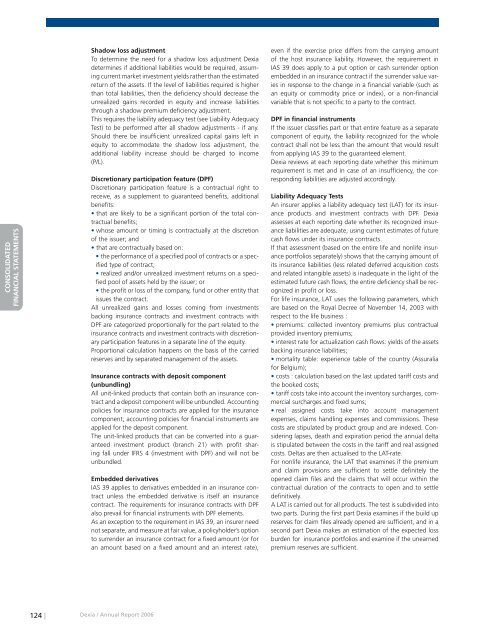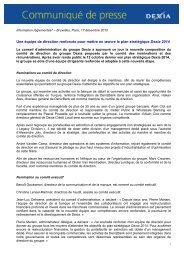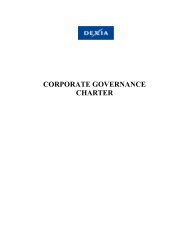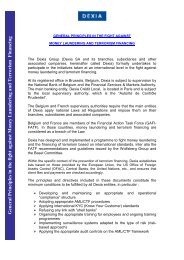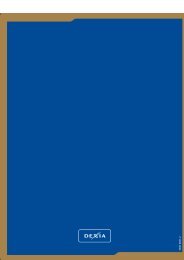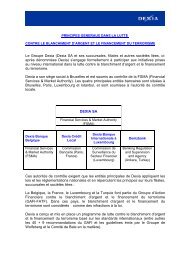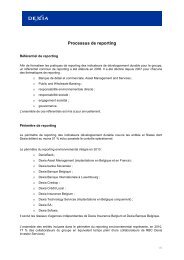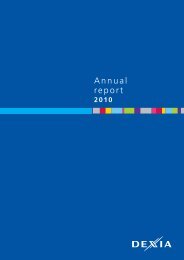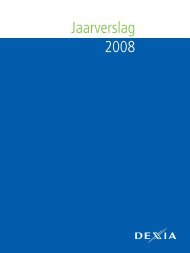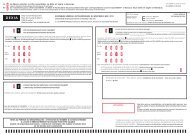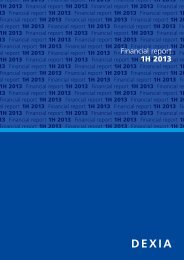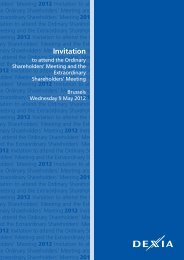Annual report 2006 - Dexia.com
Annual report 2006 - Dexia.com
Annual report 2006 - Dexia.com
You also want an ePaper? Increase the reach of your titles
YUMPU automatically turns print PDFs into web optimized ePapers that Google loves.
RAPPORT DE GESTION<br />
CONSOLIDATED<br />
FINANCIAL STATEMENTS<br />
COMPTES SOCIAUX<br />
Shadow loss adjustment<br />
To determine the need for a shadow loss adjustment <strong>Dexia</strong><br />
determines if additional liabilities would be required, assuming<br />
current market investment yields rather than the estimated<br />
return of the assets. If the level of liabilities required is higher<br />
than total liabilities, then the deficiency should decrease the<br />
unrealized gains recorded in equity and increase liabilities<br />
through a shadow premium deficiency adjustment.<br />
This requires the liability adequacy test (see Liability Adequacy<br />
Test) to be performed after all shadow adjustments - if any.<br />
Should there be insufficient unrealized capital gains left in<br />
equity to ac<strong>com</strong>modate the shadow loss adjustment, the<br />
additional liability increase should be charged to in<strong>com</strong>e<br />
(P/L).<br />
Discretionary participation feature (DPF)<br />
Discretionary participation feature is a contractual right to<br />
receive, as a supplement to guaranteed benefits, additional<br />
benefits:<br />
• that are likely to be a significant portion of the total contractual<br />
benefits;<br />
• whose amount or timing is contractually at the discretion<br />
of the issuer; and<br />
• that are contractually based on:<br />
• the performance of a specified pool of contracts or a specified<br />
type of contract;<br />
• realized and/or unrealized investment returns on a specified<br />
pool of assets held by the issuer; or<br />
• the profit or loss of the <strong>com</strong>pany, fund or other entity that<br />
issues the contract.<br />
All unrealized gains and losses <strong>com</strong>ing from investments<br />
backing insurance contracts and investment contracts with<br />
DPF are categorized proportionally for the part related to the<br />
insurance contracts and investment contracts with discretionary<br />
participation features in a separate line of the equity.<br />
Proportional calculation happens on the basis of the carried<br />
reserves and by separated management of the assets.<br />
Insurance contracts with deposit <strong>com</strong>ponent<br />
(unbundling)<br />
All unit-linked products that contain both an insurance contract<br />
and a deposit <strong>com</strong>ponent will be unbundled. Accounting<br />
policies for insurance contracts are applied for the insurance<br />
<strong>com</strong>ponent; accounting policies for financial instruments are<br />
applied for the deposit <strong>com</strong>ponent.<br />
The unit-linked products that can be converted into a guaranteed<br />
investment product (branch 21) with profit sharing<br />
fall under IFRS 4 (investment with DPF) and will not be<br />
unbundled.<br />
Embedded derivatives<br />
IAS 39 applies to derivatives embedded in an insurance contract<br />
unless the embedded derivative is itself an insurance<br />
contract. The requirements for insurance contracts with DPF<br />
also prevail for financial instruments with DPF elements.<br />
As an exception to the requirement in IAS 39, an insurer need<br />
not separate, and measure at fair value, a policyholder’s option<br />
to surrender an insurance contract for a fixed amount (or for<br />
an amount based on a fixed amount and an interest rate),<br />
even if the exercise price differs from the carrying amount<br />
of the host insurance liability. However, the requirement in<br />
IAS 39 does apply to a put option or cash surrender option<br />
embedded in an insurance contract if the surrender value varies<br />
in response to the change in a financial variable (such as<br />
an equity or <strong>com</strong>modity price or index), or a non-financial<br />
variable that is not specific to a party to the contract.<br />
DPF in financial instruments<br />
If the issuer classifies part or that entire feature as a separate<br />
<strong>com</strong>ponent of equity, the liability recognized for the whole<br />
contract shall not be less than the amount that would result<br />
from applying IAS 39 to the guaranteed element.<br />
<strong>Dexia</strong> reviews at each <strong>report</strong>ing date whether this minimum<br />
requirement is met and in case of an insufficiency, the corresponding<br />
liabilities are adjusted accordingly.<br />
Liability Adequacy Tests<br />
An insurer applies a liability adequacy test (LAT) for its insurance<br />
products and investment contracts with DPF. <strong>Dexia</strong><br />
assesses at each <strong>report</strong>ing date whether its recognized insurance<br />
liabilities are adequate, using current estimates of future<br />
cash flows under its insurance contracts.<br />
If that assessment (based on the entire life and nonlife insurance<br />
portfolios separately) shows that the carrying amount of<br />
its insurance liabilities (less related deferred acquisition costs<br />
and related intangible assets) is inadequate in the light of the<br />
estimated future cash flows, the entire deficiency shall be recognized<br />
in profit or loss.<br />
For life insurance, LAT uses the following parameters, which<br />
are based on the Royal Decree of November 14, 2003 with<br />
respect to the life business :<br />
• premiums: collected inventory premiums plus contractual<br />
provided inventory premiums;<br />
• interest rate for actualization cash flows: yields of the assets<br />
backing insurance liabilities;<br />
• mortality table: experience table of the country (Assuralia<br />
for Belgium);<br />
• costs : calculation based on the last updated tariff costs and<br />
the booked costs;<br />
• tariff costs take into account the inventory surcharges, <strong>com</strong>mercial<br />
surcharges and fixed sums;<br />
• real assigned costs take into account management<br />
expenses, claims handling expenses and <strong>com</strong>missions. These<br />
costs are stipulated by product group and are indexed. Considering<br />
lapses, death and expiration period the annual delta<br />
is stipulated between the costs in the tariff and real assigned<br />
costs. Deltas are then actualised to the LAT-rate.<br />
For nonlife insurance, the LAT that examines if the premium<br />
and claim provisions are sufficient to settle definitely the<br />
opened claim files and the claims that will occur within the<br />
contractual duration of the contracts to open and to settle<br />
definitively.<br />
A LAT is carried out for all products. The test is subdivided into<br />
two parts. During the first part <strong>Dexia</strong> examines if the build up<br />
reserves for claim files already opened are sufficient, and in a<br />
second part <strong>Dexia</strong> makes an estimation of the expected loss<br />
burden for insurance portfolios and examine if the unearned<br />
premium reserves are sufficient.<br />
124 |<br />
<strong>Dexia</strong> / <strong>Annual</strong> Report <strong>2006</strong>


